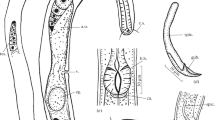Abstract
The freshwater fish nematode Camallanus cotti Fujita, 1927 (Spirurida: Camallanidae) is naturally distributed in East, South and Southeast Asia. During the past three or four decades the species has been disseminated to Europe, North America, Australia and Hawaii, mainly due to the extensive ornamental fish trade. In the present study, its development and larval morphogenesis is described. Newborn first-stage larvae are ingested by copepods and within hours reach the haemocoel, where the worms moult twice. At 22 °C ambient temperature, fully-developed third-stage larvae appear on day 11 p.i. After transmission into the fish intestine two further moults occur before the adult stage is reached. At 23 °C water temperature, the final moult is initiated around day 33 p.i. in males and between 34 and 42 days p.i. in females. Morphologically the young and older adults are similar, but the buccal capsule of both young males and young females is not yet fully sclerotised. Based on the close similarity in the development and adult morphology of the buccal capsule in C. cotti and three congeners from Europe and North America, we suggest, in general agreement with earlier workers, that the Camallanus Railliet & Henry, 1915 originated in tropical Asia and subsequently radiated to species when adapting to new climatic and/or host-related conditions in the Old World and the New World. C. cotti may thus represent a lineage of speciation which did not apparently involve extensive changes in relation to their natural geographical distribution or definitive host range.
Similar content being viewed by others
References
Campana-Rouget, Y. (1961) Remarques sur le cycle évolutif de Camallanus lacustris (Zoega, 1776) et la phylogenie des Camallanidae. Annales de Parasitologie Humaine et Comparée, 36, 425–434.
Campana-Rouget, Y., Petter, A.J., Kremer, M., Molet, B. & Miltgen, F. (1976) Présence du nématode Camallanus fotedari dans le tube digestif de poissons d'aquarium de diverses provenances. Bulletin de l'Academie Véterinaire de France, 49, 205–210.
Evans, B.B. & Lester, R.J.G. (2001) Parasites of ornamental fish imported into Australia. Bulletin of the European Association of Fish Pathologists, 21, 51–55.
Fagerholm, H.-P. (1979) Nematode length and preservatives, with a method for determining the length of live specimens. Journal of Parasitology, 65, 334–335.
Fagerholm, H.-P. & Løvdahl, M. (1979) Induced morphometric variation in the preparation of nematode parasites for LM and SEM. Systematic Parasitology, 6, 245–247.
Font, W.F. & Tate, D.C. (1994) Helminth parasites of native Hawaiian freshwater fishes: an example of extreme ecological isolation. Journal of Parasitology, 80, 682–688.
Hoffman, G.L. & Schubert, G. (1984) Some parasites of exotic fishes. In: Courtenay, W.R., Jr & Stauffer, J.R., Jr (Eds) Distribution, biology, and management of exotic fishes. Baltimore: The Johns Hopkins University Press, 430 pp.
Jackson, J.A. & R.C. Tinsley (1995) Evolutionary relationships, host range and geographical distribution of Camallanus Railliet & Henry, 1915 species (Nematoda: Camallaninae) from clawed toads of the genus Xenopus (Anura: Pipidae). Systematic Parasitology, 32, 1–21.
Kennedy, C.E.J., Endler, J.A., Poynton, S.L. & McMinn, H. (1987) Parasite load predicts mate choice in guppies. Behavioral Ecology and Sociobiology, 21, 291–295.
Levsen, A. (2001) Transmission ecology and larval behaviour of Camallanus cotti (Nematoda, Camallanidae) under aquarium conditions. Aquarium Sciences and Conservation, 3, 315–325.
Li, S.Y. (1941) On two new species of nematodes from China. Peking Natural History Bulletin, 15, 195–199.
McMinn, H. (1990) Effects of the nematode parasite Camallanus cotti on sexual and non-sexual behaviors in the guppy (Poecilia reticulata). American Zoologist, 30, 245–249.
Moravec, F., (1994) Parasitic nematodes of freshwater fishes of Europe. Dordrecht, The Netherlands: Kluwer Academic Publishers, 473 pp.
Moravec, F. & Nagasawa, K. (1989) Observations on some nematodes parasitic in Japanese freshwater fishes. Folia Parasitologica, 36, 127–141.
Moravec, F. & Sey, O. (1988) Nematodes of freshwater fishes from North Vietnam. Part 1. Camallanoidea and Habronematoidea. Vestnik Československé Společností Zoologické, 52, 128–148.
Petter, A.J. (1979) Essai de classification de la sous-famille des Camallaninae. Bulletin du Museum National d'Histoire Naturelle, Paris, 4e sér., 1, section A, 991–1008.
Raina, M.K. & Dhar, R.L. (1972) On Camallanus fotedari n. sp. (Nematoda: Spiruridea) from the intestine of Nemachilus kashmirensis in Kashmir, India. Journal of Helminthology, 46, 157–160.
Rigby, M.C., Font, W.F. & Deardorff, T.L. (1997) Redescription of Camallanus cotti Fujita, 1927 (Nematoda: Camallanidae) from Hawai'i. Journal of Parasitology, 83, 1161–1164.
Rothwell, T.L.W. (1989) Immune expulsion of parasitic nematodes from the alimentary tract. International Journal for Parasitology, 19, 139–168.
Schubert, G. (1972) A new fish enemy. Tropical Fish Hobbyist, 21, 15–20.
Stromberg, P.C. & Crites, J.L. (1974a) Specialization, body volume, and geographical distribution of Camallanidae (Nematoda). Systematic Zoology, 23, 189–201.
Stromberg, P.C. & Crites, J.L. (1974b) The life cycle and development of Camallanus oxycephalus Ward & Magath, 1916 (Nematoda: Camallanidae). Journal of Parasitology, 60, 117–124.
Stumpp, M. (1975) Untersuchungen zur Morphologie und Biologie von Camallanus cotti (Fujita, 1927). Zeitschrift für Parasitenkunde, 46, 277–290.
Yamaguti, S. (1941) Studies on the helminth fauna of Japan. Part 33. Nematodes of fishes, II. Japanese Journal of Zoology, 9, 343–396.
Author information
Authors and Affiliations
Rights and permissions
About this article
Cite this article
Levsen, A., Berland, B. The development and morphogenesis of Camallanus cotti Fujita, 1927 (Nematoda: Camallanidae), with notes on its phylogeny and definitive host range. Syst Parasitol 53, 29–37 (2002). https://doi.org/10.1023/A:1019955917509
Issue Date:
DOI: https://doi.org/10.1023/A:1019955917509




